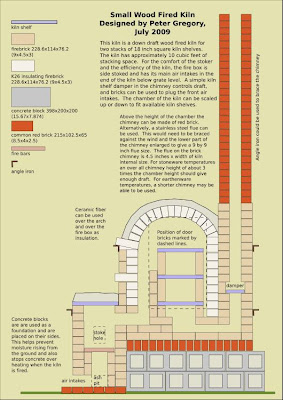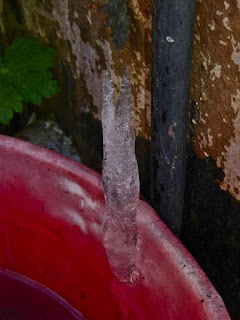A Kiln for Claire. Part One.

On June 14 Claire wrote and asked for "a few pointers on how to get started..., now that I am living on a bush block without electricity, I'm keen to fire with wood. How do I begin?"
At the time Claire wrote I was just about to get the exhibition in Dunedin started, and then I was straight into a mountain of paperwork, so my promise to try and do something "probably next week" never eventuated, for which I apologize. I have been giving the question some thought however, and thought I would launch into a mini series of posts on the subject. I hope Claire does get to see them, and will forgive my lateness with this.
Some Productive Reading
As people who have followed this blog will understand, I have had to learn about wood fired kilns without ever seeing one in action. I read books, looked at pictures, thought about it, and bought a couple of hundred second hand fire bricks and some common red bricks from a demolition yard and began. I posted photos of my series of kilns on March 21, 2009, My Woodfired Kilns All 7 and my very first one was inspired by some instructions in "The Craft Of the Potter," by Michael Casson. We gave it one firing, and it reached 1100 degrees Centigrade in only 2 and a half hours. Inspiring stuff, which proved that wood firing worked! I demolished it straight away, having ideas for a much larger kiln, and I needed the bricks!
I was reading The Kiln Book, by Fredrerick Olsen at this time, and do heartily recommend it to would be kiln builders. Olsen described many approaches to kiln construction, and gave some basic drawings of his fast fired wood kiln, the sort that has two fire boxes, one on each opposing side. Many potters have built kilns based on the Olsen fast fire kiln, so I assume it works really well. I had one or two misgivings about firing two fire boxes by myself, and also a feeling that wood firing should take longer than the 3 to 6 hour firings that seemed to be part of the fast fire thing. (I now realize that you don't have to fire a fast fire kiln that fast, but I had no experience at all then!).
Very recently I came across Kiln Construction A Brick-By-Brick Approach, by Joe Finch. This is one book that I wish I had read right at the beginning of my kiln building adventures. The kilns described in it are built on the Olsen fast fire kiln idea, but there are some really good looking refinements to the firebox and general construction that, I am sure, would lead to greater efficiency in firing, and some cost savings in construction.
I also read Kilns: Design, Construction and Operation, by Daniel Rhodes, which I also found helpful and encouraging, and introduced some nice catenary arch kilns to the range of possibilities.
I found reading an essential part of coming to grips with wood fired kilns. Ideas were able to percolate around the gray cells, and when I later started to build, things sometimes made sense!
A Question of Style!
One very important thing to establish is what sort of wood fired pottery you want to make. High fired, low fired is just a part of that. What is the look that you are after? Do you want to make work that looks like it has been blasted by a volcano, toasted and roasted and naturally glazed by ash? Or do you want the fire and drama to take second place and to just provide you with heat?
Available Materials?
We live in a place where it is rather difficult to get kiln building materials, and don't have much choice in the ones we can obtain. For example I cannot choose different qualities of the heavy sort of fire brick. I have to take what I am given. I cannot find a supplier for arch bricks. I was able to order some K26 insulation bricks, but only by describing what they were and repeatedly asking for them. Frustrating, but that is the reality for where we are. We have to therefore be flexible in thinking, and work around these problems. The availability, or lack of, some materials may be a factor in what sort of kiln you can make, but you will be able to make something!
Whilst thinking about this, I have started designing another kiln! This kiln incorporates several of the things that I found worked well for me in the other kilns that I have experimented with. I will include a glimpse of my drawing thus far with this, and explain more about it, and a much simpler kiln in "A Kiln for Claire. Part 2.


Comments
I think winter time is just right for having happy kiln design thoughts. I am sure that the birds must do the same as they overwinter somewhere and dream of the nest they will build in spring!
All the Best to you, Peter
Really interesting blog so will add you to my blog roll.
Thank you for your kind words. Welcome to my blog. Do drop in and visit if you are down this way, we are here most days, but please give a ring to let us know you are coming so we can be sure to be in.
Best Wishes,
Peter